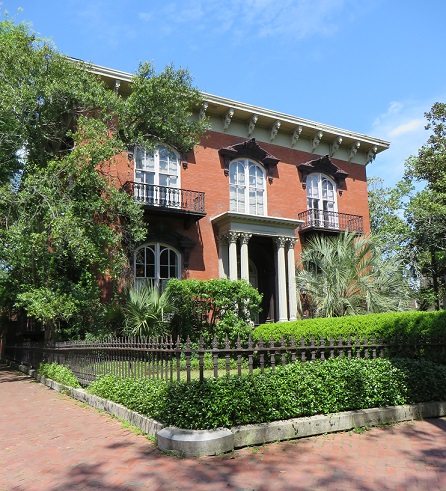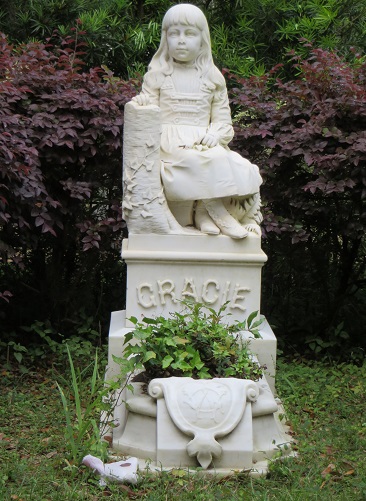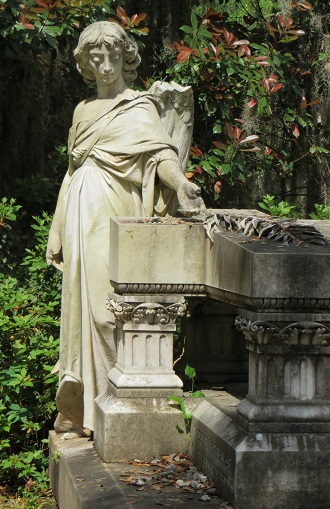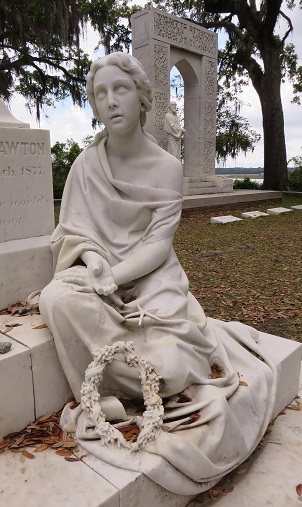Savoring Savannah
To catch up everything up from the events of our last post, we did end up adding another week to our stay at Savannah Oaks RV Resort. The gentleman who had the accident and whose dog we were watching had to have brain surgery to alleviate the pressure from the hematoma and resulting clot, but was released from the hospital into the care of his friend who had arrived a couple days after it all happened. We were very glad everything turned out okay for the gentleman and hope him and his sweet dog all the best in the future.
Since we added the extra week to our stay, and no longer had dog-watching duty, we ventured into downtown Savannah to have lunch at Mrs. Wilkes Dining Room and explore a bit. The lunch was awesome, and both of us ate a bit (okay – a lot) more than we should have. It was definitely some of the best fried chicken I’ve ever had, and each of the extremely plentiful side dishes that sprawled across our family-style table of 10 people seemed even more delicious than the one previous. It was a lot of fun talking with the rest of the table between bites, learning where everyone was from, how long they’d been in Savannah, and what they’d recommend seeing in the city. At the conclusion of the meal, the 10 of us had eaten about 90% of what had been presented for our gastronomic delight and each of us pronounced ourselves stuffed. We waddled up to the register to pay, then went our separate ways, hoping to walk off at least some of the absolutely divine calories we’d consumed.
We strolled past the Mercer-Williams House and stopped to check it out, but didn’t see any of the ghosts that are said to haunt the place due to the several deaths that had occurred there. In addition to the events that are recounted in John Berendt’s book Midnight in the Garden of Good and Evil, there had been two other tragedies within the home’s environs. A previous owner had tripped over the second floor banister, fractured his hip, suffered a concussion, and died 3 days later, and a young boy who was chasing pigeons on the roof had slipped and fallen, impaling himself on the wrought-iron fence that surrounds the home. Maybe the ghosts were just shy that day, but we continued on our way with nary a cold chill or raised hair. Our final stop for the day was Forsyth Park. As everyone does, we stopped to photograph the fountain, then moved on to view the Confederate Memorial and enjoy the fragrance garden.

The Mercer-Williams House, featured in the book “Midnight in the Garden of Good and Evil”.

The fountain at Forsyth Park. Probably the most photographed landmark in Savannah.

The Confederate War Memorial in Forsyth Park.

A rose blooming within the Fragrance Garden at Forsyth Park.
The next day, we headed over to Bonaventure Cemetery. That might not sound like much of a tourist destination to most people, but Bonaventure is an absolutely beautiful and historical cemetery that seems to draw visitors like a magnet. Containing the final resting places of several Confederate generals, lyricist Johnny Mercer, and writer Conrad Aiken, along with many others, Bonaventure also feels like a sculpture garden, as quite a few of the plots are graced with elaborate monuments to those that have been buried there. There are also memorials for World War veterans and for victims of the Jewish Holocaust. It was definitely worth the few hours we spent walking through the grounds, reading inscriptions on the stones and feeling the ever-present peace that lies upon the grounds.

An ornate Celtic cross monument marking a grave site in Bonaventure Cemetery.

Little Gracie Watson, who died of pneumonia in 1889. Her monument is said to be a life-sized and picture perfect representation.

One of many angels adorning the graves at Bonaventure Cemetery.

Another intricately sculpted grave monument at Bonaventure Cemetery.

One of the more massive monuments in Bonaventure Cemetery.

A hauntingly poignant memorial at Bonaventure Cemetery. Note the fingers on the sculpture that have been broken off by careless or souvenir-seeking visitors.
After Savannah Oaks, we drifted slowly up the East Coast, stopping for a night at Bass Lake Campground in Dillon, SC (just one exit shy of that famous tourist trap known as South of the Border), then settled in for a week in Roanoke Rapids, NC at The RV Resort at Carolina Crossroads. This is just a planned stop to kill a bit more time before we head up towards Manassas, VA and Washington, D.C. Hopefully we’ll find out this week if we managed to score a tour of the White House while we’re there.
Until next post…




















